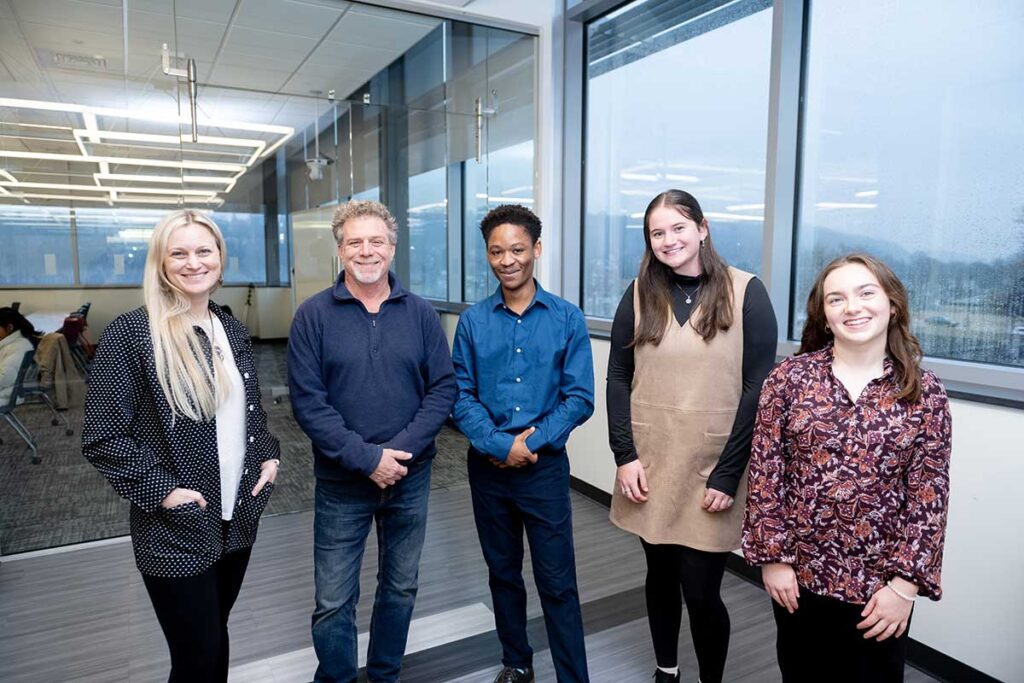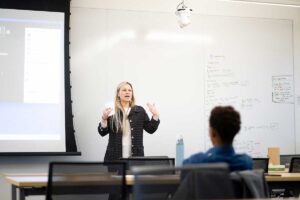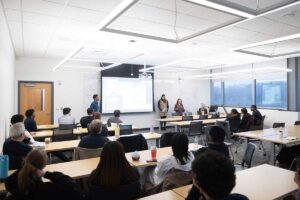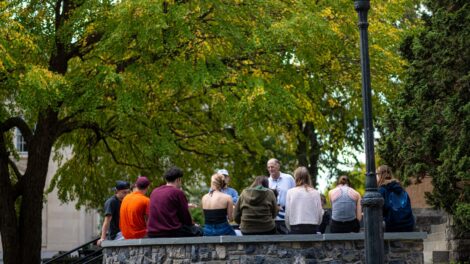Bringing the art of spoken word to Karl Stirner Arts Trail

(From left to right) Prof. Sarah Appelhans, Prof. Jim Toia, Don Bosco Haingura ’25, Eva Drotch ’25, and Emily Mastroly ’25. | Photo by Adam Atkinson
By Stella Katsipoutis-Varkanis
Three students in Prof. Sarah Appelhans’ fall EGRS 451: Senior Capstone Seminar in Engineering and Society course designed a new Karl Stirner Arts Trail exhibit that merges technology, art, nature, and wellness in a way the Easton community has never seen before. Eva Drotch ’25, Don Bosco Haingura ’25, and Emily Mastroly ’25 spent the semester creating the blueprint for the Spoken Word Project—an art installation intended to showcase, and encourage trail visitors to interact with, poetry.
“It’s the first exhibit on the Karl Stirner Arts Trail with an audio component,” Mastroly says. “I’m excited by how much bigger the project has become than myself and the class as a whole. It’s a project by the community, for the community.”
Under the guidance of Appelhans, assistant professor of engineering studies, and Jim Toia, director of community-based teaching and director of the Karl Stirner Arts Trail, the students leveraged their engineering design and research skills to tailor the project specifically to the Easton community—while also keeping in mind the practicalities of creating public art.
In addition to potentially helping to further engagement with the arts trail and get more locals outdoors, the exhibit, Toia says, will be an opportunity for poets across Lafayette’s campus, the Lehigh Valley, and the country to submit their work to be shared with the general public. “More importantly, it will help marginalized poetry groups have their voice heard in a safe, protected environment,” Toia adds.
To flesh out the details of their final design—which they formally presented at the Engineering Studies Capstone Presentations on Dec. 9, 2024—Drotch, Haingura, and Mastroly collaborated with faculty and staff across the Lafayette campus, as well as with members of the Karl Stirner Arts Trail advisory board.

Appelhans addresses the audience at the EGRS 451 capstone presentation. | Photo by Adam Atkinson
“You always learn something through collaborating with people from different disciplinary backgrounds, and I love how this course builds bridges between engineering and the arts,” Appelhans says. “Engineering students often have other interests, and many are artists. This experience gave them the chance to bring their whole selves to a project while also developing their skills as engineers. And with its focus on liberal arts and interdisciplinarity, Lafayette is a particularly great place to do this kind of work.”
She adds that the Landis Center for Community Engagement was a tremendous resource to her as well, helping her to build relationships throughout the local community that were crucial to the course.
During the course, Appelhans also stressed to the students the importance of directly talking to those who will eventually be using the technical designs they’re creating. “The students surveyed people who walk the arts trail and gathered their feedback on how they could see themselves interacting with a spoken word installation there,” she says.

(From left to right) Haingura, Drotch, and Mastroly presented the KSAT Spoken Word Project at the EGRS 451 capstone presentation Dec. 9, 2024. | Photo by Adam Atkinson
Toia and Appelhans both emphasize how impressed they are by not only the students’ final blueprint but also their commitment through the trial-and-error process of designing it. “What I’m learning as a professor is that if you step back and allow students to use their creativity and knowledge, they can come up with things you never would have imagined,” Appelhans says. “It’s my hope that they’re learning skills they can take with them into their future careers, and feel empowered to do things that help people.”
Mastroly, who plans to work full time in water and wastewater engineering upon graduating, says the project management skills she gained from the experience will be especially useful in her role working directly with project managers at Herbert, Rowland, & Grubic Inc.
For the next phase of the project, students taking the EGRS 480: Sustainable Solutions course this spring will be working alongside Toia to begin building the design that was mapped out by Drotch, Haingura, and Mastroly. Full details of the finished installation are still to be determined, Toia explains. “We’ve applied for two grants over the next two years. So, depending on what funding we’re potentially awarded, we’ll be able to figure out exactly what the finished product will look like. We’re very flexible, confident, and excited about how everything will come to fruition.”

